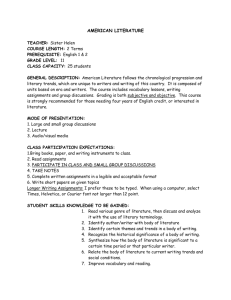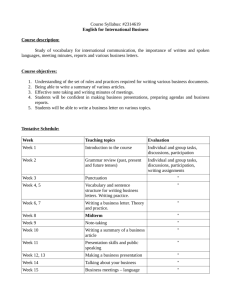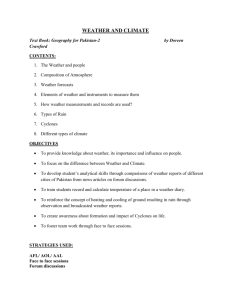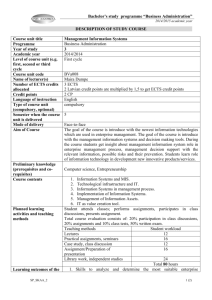Technolgies for Teaching and Learning
advertisement
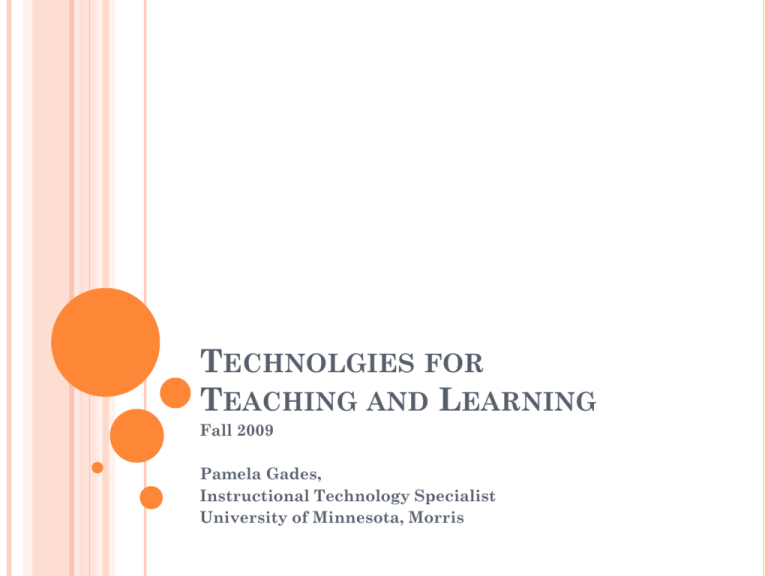
TECHNOLGIES FOR TEACHING AND LEARNING Fall 2009 Pamela Gades, Instructional Technology Specialist University of Minnesota, Morris INTRO Here are seven principles based on research on good teaching and learning in colleges and universities. Good practice in undergraduate education: encourages contact between students and faculty, develops reciprocity and cooperation among students, encourages active learning, gives prompt feedback, emphasizes time on task, communicates high expectations, and respects diverse talents and ways of learning. 2 INTRO While each practice can stand alone on its own, when all are present their effects multiply. Together they employ six powerful forces in education: activity, expectations, cooperation, interaction, diversity, and responsibility. 3 COMMUNICATION Encourages Frequent Contact Between Students and Faculty Email Forum Blog Wiki Establish policies for your course regarding usage of the tools, and timelines for responding to messages. 4 TECHNOLOGY FOR COMMUNICATION Email: timely email responses encourage contact Electronic journals: Students journal weekly and reflect on their thoughts and feelings about the class. The instructor responds to each student’s weekly journal. Discussion boards: Encourage student participation by sending them private email. Online office hours via chat or web conferencing Telephone/voicemail/text messaging Electronic submission of assignments 5 TECHNOLOGY FOR COMMUNICATION (CONT’D) Use the Comment feature in Word (or Acrobat) to respond to student work electronically Post your schedule online for students Use a course management system (Moodle or WebVista) 6 COLLABORATION/COOPERATION Develops Reciprocity and Cooperation Among Students Guidelines for encouraging meaningful participation in online discussions: Learners should be required to participate (and their grade should depend on participation). Discussion groups should remain small. Discussions should be focused on a task. Tasks should always result in a product. Tasks should engage learners in the content. Learners should receive feedback on their discussions. Evaluation should be based on the quality of postings (and not the length or number). Instructors should post expectations for discussions. 7 TECHNOLOGY FOR COLLABORATION Class assignments worked on in small groups, but discussed openly through a discussion board “Jeopardy” type games using classes broken into smaller teams Use course management system to create groups and then use discussion boards either in private group discussions or allowing anyone to read any group’s discussions Use a discussion board for students to post rough drafts of work that others can critique Teams collaborate on a group project via a discussion board 8 TECHNOLOGY FOR COLLABORATION (CONT’D) Teams use email groups to share & collaborate Structured WebQuests Web page construction by teams of students Chat rooms Google Docs or using Microsoft Word collaborative tools Collaborative electronic portfolios Email Listservs “Continue class discussions online amongst yourselves” Create group Blogs 9 ACTIVE LEARNING - PROJECTS Talk about it Write about it Relate it to past experiences Apply it to their daily lives Students should present course projects. This often motivates them to perform at a higher level. They learn from seeing and discussing their peer’s work. 10 TECHNOLOGY FOR ACTIVE LEARNING Create a set of practical projects and allow groups to choose a project. These projects can be presented in the classroom or a group Web site or Blog can be assigned Interacting with animations, simulations, and games Allowing students to research topics during class using their laptops Playing video clips, or creating video clips to demonstrate learning 11 TECHNOLOGY FOR ACTIVE LEARNING (CONT’D) Extend research outside the classroom, students then post findings to the discussion board or create Blog or Wiki entries to report their findings Analysis of real world case studies “Tour” a place via the Web Set up a video conferences with professionals in the field Interact with online laboratory exercises 12 TECHNOLOGY FOR ACTIVE LEARNING (CONT’D) Use in-class polling software to pose questions and have students work in small groups to discuss and agree on answers Student Response Systems (“clickers”) Assign students to use Twitter to post news, links, and thoughts on course topics Use Twitter in class to display a class Twitter site. Students post throughout the class period to share thoughts and ideas Post lecture outlines on a course Web site that students can use and customize prior to class and record notes on during class 13 PROVIDE PROMPT FEEDBACK Instructors need to provide two types of feedback: Acknowledgement Feedback: Confirms that some event has occurred. For example, the instructor may send an e-mail acknowledging that he or she has received a question or assignment and will respond soon. Information Feedback: provides information or evaluation, such as an answer to a question, or an assignment grade and comments Give them frequent opportunities to perform and receive suggestions for improvement 14 TECHNOLOGIES FOR PROMPT FEEDBACK Assignments submitted electronically are easily commented on and returned electronically Course management systems allow for easy notification of submissions, which helps instructors to promptly respond Email each student upon receipt of their assignment, just to let him/her know that it was received Classroom response systems (“clickers”) permit immediate feedback 15 TECHNOLOGIES FOR PROMPT FEEDBACK (CONT’D) Post on a discussion board to give encouragement and feedback to students who are posting Electronic Portfolios: An online portfolio allows the student to store selected papers and projects and allows faculty to attach comments to those papers and projects Email your students for announcements, to give feedback on assignments, or to follow-up on something from class Use polls or surveys to help reshape the course as it unfolds 16 TIME ON TASK Time + Energy = Learning There is no substitute for time on task. Teach them effective time management. Allocate realistic amounts of time. Regularly-distributed deadlines encourage students to spend time on tasks and help students with busy schedules avoid procrastination. They also provide a context for regular contact with the instructor and peers. 17 TECHNOLOGIES FOR TIME ON TASK Online submission of assignments helps the students complete assignments on time Post all assignments on the course Web site Have students store all their work in their network file storage space --- minimizes lost or corrupted files Create online auto-graded quizzes and surveys for students to test themselves and repeat as many times as they like Create and assign WebQuests Online discussions and chats 18 TECHNOLOGIES FOR TIME ON TASK (CONT’D) Recorded lectures or additional concept presentations (podcasts or vodcasts) Provide hot links to articles and other readings which means less time students spend searching for materials in the library (also electronic reserves) Post class notes online for student review (so review of the material in class is not required) Use the online calendar tool in WebVista or Moodle to help students plan and organize 19 COMMUNICATING HIGH EXPECTATIONS Expect more and you’ll get more. High expectations are important for everyone. Provide examples or models for students to follow, along with comments explaining why the examples are good. Provide examples of the types of interactions you expect from the discussion forum. What to do. What not to do. Praise for quality work. 20 TECHNOLOGIES FOR COMMUNICATING HIGH EXPECTATIONS Grade weekly online discussion board postings. Give feedback as to what is an outstanding response, and what is not. Provide a scoring rubric for every assignment, posted online for students to refer to at any time Especially useful for group work are learning contracts Post group results and finished projects online – “meaningful audience concept” Post examples of exemplary work Provide weekly progress reports 21 RESPECTS DIVERSE TALENTS AND WAYS OF LEARNING There are many roads to learning. People bring different talents and styles of learning to college. Students need the opportunity to show their talents and learn in ways that work for them. Students then can be pushed to learn in new ways that do not come so easily. Allow students to choose project topics Allow students to select a method for a project: write a paper, create a video, present in class, create a web site, etc. 22 TECHNOLOGIES FOR RESPECTING DIVERSE TALENTS AND WAYS OF LEARNING Utilize WebQuests or multimedia presentations as a way to infuse the curriculum with diverse viewpoints. Offer students choices of activities according to their learning styles: Simulated case studies Videos Computer-aided instructional packages Articles, books, and Web sites Oral presentations, demonstrations, multi-media presentations, visual aids, audio aids, and more 23 TECHNOLOGIES FOR RESPECTING DIVERSE TALENTS AND WAYS OF LEARNING (CONT’D) Provide lecture slides and notes online prior to class Provide a mix of communication media: Allow students to use email to ask questions Some prefer face-to-face interactions Post Use everything online for 24/7 access by students discussion boards for homework help, peer networking 24 TECHNOLGIES FOR TEACHING AND LEARNING Fall 2009 Pamela Gades, Instructional Technology Specialist University of Minnesota, Morris

![Syllabus [Word]](http://s3.studylib.net/store/data/006967311_1-8dc868a12812e520f131dbbe02cc269a-300x300.png)
